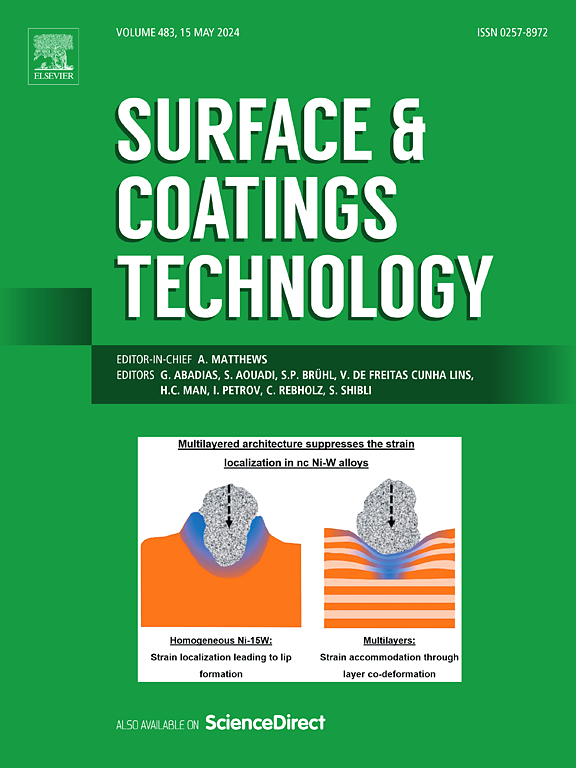燃气轮机部件NiCoCrAlY LMD中轨迹几何、微观结构和相形成的实时热特征分析和Scheil模拟
IF 5.3
2区 材料科学
Q1 MATERIALS SCIENCE, COATINGS & FILMS
引用次数: 0
摘要
本研究提出了一种结合实时工艺温度监测和基于scheil的CALPHAD模拟的集成方法,以研究在Inconel 718衬底上NiCoCrAlY轨道激光金属沉积(LMD)的工艺-结构-性能关系,旨在用于燃气轮机应用。通过分析红外高温计捕获的实时热特征,将其与轨道几何形状、微观结构、相形成和机械性能相关联。同时,基于scheil的CALPHAD模拟,通过XRD和Rietveld细化验证,用于预测基于不同工艺参数引起的成分变化的相演化。β-NiAl (BCC)和γ-Ni (FCC)相被确定为主要成分,它们的相对比例对稀释高度敏感,主要受扫描速度而不是功率的影响。扫描速度的增加导致稀释度的增加和γ-Ni分数的增加,β-NiAl含量从58%降低到14%,这与显微硬度从510下降到346 HVN 0 . 2直接相关。热分析表明,熔池寿命和峰值温度,而不是冷却速度,与产生的机械性能有很强的相关性。较长的熔池寿命(180-230 ms)和峰值温度在1940-2000°C左右归因于β主导的显微组织和增强的硬度。优化后的轨迹在800w和600mm /min下产生,划痕硬度为2.85±0.22 GPa,是衬底的两倍多,具有优异的耐磨性。该研究强调,将热特征分析与Scheil模拟相结合,为NiCoCrAlY涂层LMD中的相和力学性能控制提供了可靠的预测框架。本文章由计算机程序翻译,如有差异,请以英文原文为准。
Analysis of real-time thermal signatures and Scheil simulation for track geometry, microstructure, and phase formation in LMD of NiCoCrAlY for gas-turbine components
This study presents an integrated approach combining real-time process temperature monitoring and Scheil-based CALPHAD simulations to investigate the process–structure–property relationship in laser metal deposition (LMD) of NiCoCrAlY tracks on an Inconel 718 substrate, aimed at gas turbine applications. Real-time thermal signatures captured by an IR pyrometer were analyzed to correlate those with track geometry, microstructure, phase formation, and mechanical properties. Concurrently, Scheil-based CALPHAD simulations, validated through XRD and Rietveld refinement, were used to predict phase evolution based on compositional changes induced by varying process parameters. The β-NiAl (BCC) and γ-Ni (FCC) phases were identified as dominant constituents, with their relative proportions highly sensitive to dilution, governed primarily by scan speed rather than power. Increased scan speed led to greater dilution and higher γ-Ni fraction, reducing β-NiAl content from 58 % to 14 %, which directly correlated with a drop in microhardness from 510 to 346 HVN₀.₂. Thermal analysis revealed that melt pool life and peak temperature, rather than cooling rate, exhibited a strong correlation with resulting mechanical properties. A longer melt pool life (180–230 ms) and a peak temperature around 1940–2000 °C are attributed to β-dominated microstructures with enhanced hardness. The optimized track, produced at 800 W and 600 mm/min, demonstrated a scratch hardness of 2.85 ± 0.22 GPa, more than twice that of the substrate, indicating superior wear resistance. This study highlights that combining thermal signature analysis with Scheil simulation provides a reliable predictive framework for controlling phases and mechanical properties in LMD of NiCoCrAlY coatings.
求助全文
通过发布文献求助,成功后即可免费获取论文全文。
去求助
来源期刊

Surface & Coatings Technology
工程技术-材料科学:膜
CiteScore
10.00
自引率
11.10%
发文量
921
审稿时长
19 days
期刊介绍:
Surface and Coatings Technology is an international archival journal publishing scientific papers on significant developments in surface and interface engineering to modify and improve the surface properties of materials for protection in demanding contact conditions or aggressive environments, or for enhanced functional performance. Contributions range from original scientific articles concerned with fundamental and applied aspects of research or direct applications of metallic, inorganic, organic and composite coatings, to invited reviews of current technology in specific areas. Papers submitted to this journal are expected to be in line with the following aspects in processes, and properties/performance:
A. Processes: Physical and chemical vapour deposition techniques, thermal and plasma spraying, surface modification by directed energy techniques such as ion, electron and laser beams, thermo-chemical treatment, wet chemical and electrochemical processes such as plating, sol-gel coating, anodization, plasma electrolytic oxidation, etc., but excluding painting.
B. Properties/performance: friction performance, wear resistance (e.g., abrasion, erosion, fretting, etc), corrosion and oxidation resistance, thermal protection, diffusion resistance, hydrophilicity/hydrophobicity, and properties relevant to smart materials behaviour and enhanced multifunctional performance for environmental, energy and medical applications, but excluding device aspects.
 求助内容:
求助内容: 应助结果提醒方式:
应助结果提醒方式:


